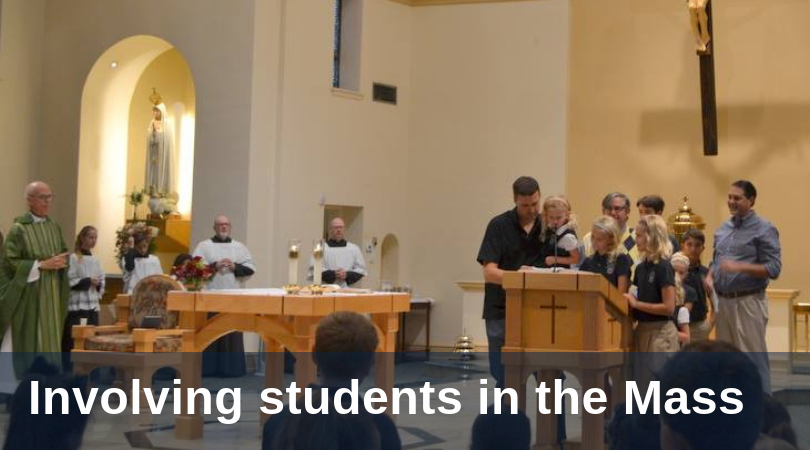 One of the defining marks of a Catholic school is the communal celebration of the Sacraments. Growing up as a student in a Catholic school, I remember having all-school Masses once each quarter. When I began teaching at St. Paul Catholic School in St. Petersburg, Florida, I was delighted to learn that our school gathered every week to celebrate Mass. As the middle school religion teacher, I had the opportunity to coordinate these weekly all-school Masses and facilitate student involvement. Here are a few of the best practices I learned along the way:
One of the defining marks of a Catholic school is the communal celebration of the Sacraments. Growing up as a student in a Catholic school, I remember having all-school Masses once each quarter. When I began teaching at St. Paul Catholic School in St. Petersburg, Florida, I was delighted to learn that our school gathered every week to celebrate Mass. As the middle school religion teacher, I had the opportunity to coordinate these weekly all-school Masses and facilitate student involvement. Here are a few of the best practices I learned along the way:
Involving students in the Liturgy
All catechesis should promote a knowledge of the liturgy and sacraments, but effective catechesis also encourages full, conscious and active participation in the liturgy. Involving students in both planning the liturgy and serving in appropriate liturgical roles helps to facilitate both knowledge of and participation in the liturgy.
Planning the liturgy - At our school, one class from grades 3-8 was responsible for helping plan the weekly all-school liturgy. Whenever my middle school classes were responsible for preparing for Mass, we would spend an entire class period on our preparations. We would assign lectors, and our trained altar servers would volunteer to serve during the Mass. When the younger grades were responsible for planning Mass, the middle school students would assist as altar servers. Teachers, administrators and parents would serve as Extraordinary Ministers of Holy Communion.
Writing intercessions - During the remainder of the class period after roles were assigned, the students would work in groups to write the prayers of the faithful. Each group was tasked with writing at least four prayers, as outlined by the General Instruction of the Roman Missal: 1) for the needs of the Church, 2) for public authorities and the salvation of the whole world, 3) for those burdened by any kind of difficulty, 4) for the local community. They received 10 points for turning in their completed prayers and one extra credit point for each prayer that was selected to be used during Mass.
Learning the Psalm - To assist the school in singing the psalm response, the students would prepare a ‘psalm board'—a poster that had the psalm response written out in big, bold letters and was colorfully decorated. Several students would work on writing out and decorating the psalm board, and one or two students were assigned the responsibility of holding it up in front of the school community while the psalm response was sung.
Enacting the saint or reading - Occasionally, we would prepare a skit to act out one of the readings or the life of a saint whose feast we would be celebrating. Enacting a reading or the life of a saint in the classroom helped the students to pay closer attention to the readings and homily at Mass.
Preparing the readers and servers - On Wednesday mornings, I would meet any students in the church who were assisting with Mass so that they could practice their readings (“Read slooowly and loudly!”) and get comfortable in their liturgical roles.
Setting High Expectations for Student Behavior
Any parent who has taken their family to Mass knows that it can be challenging for a child to remain quiet and attentive during Mass. Taking 300 children to Mass at once sounds like a recipe for disaster! We found that one of the best ways to promote good behavior during school Masses is to give the older students the responsibility to assist with the younger students.
We would have the older grades sit with their “buddies” from the younger grades. For example, each 7th grade student would sit with one or two kindergarten students. This practice reminded the older students to behave like responsible role models; it also allowed the older students to assist the teachers by attending to the younger students’ needs.
While we weren’t without our share of disruptions and behavior problems, I was amazed by the overall ability of the students to participate prayerfully in the liturgy.
Involving Families in the School Masses
Since parents are called to be the primary catechists for their children, it’s important to invite their participation in the school liturgies as well. Parents and members of the parish community were always welcome (and encouraged!) to attend our school Masses.
In addition to regular attendance, parents were also periodically invited to have more direct involvement in the Mass. A couple times each year we would host a “Mass for Dads” and a “Mass for Moms” for which we would invite parents, guardians and grandparents to serve in liturgical roles along with the students. For example, parents would serve as altar servers alongside their children, stand with their children as they read at the ambo and serve alongside teachers as Extraordinary Ministers of Holy Communion.
The Eucharist is the “source and summit” of our faith and should be celebrated frequently in our Catholic schools. While Sunday Masses allow children to experience the liturgy with their families and within the context of the broader parish community, weekday school Masses allow children the opportunity to take on ministerial leadership roles and experience God’s grace with their peers. Both of these experiences—participation in a multigenerational faith community and liturgical celebrations planned specifically with the children in mind—create space for God to work in the hearts of these children and bring them into deeper communion with Him.
Have ideas or insights from your own experience? Please share them with us in the comments below!


